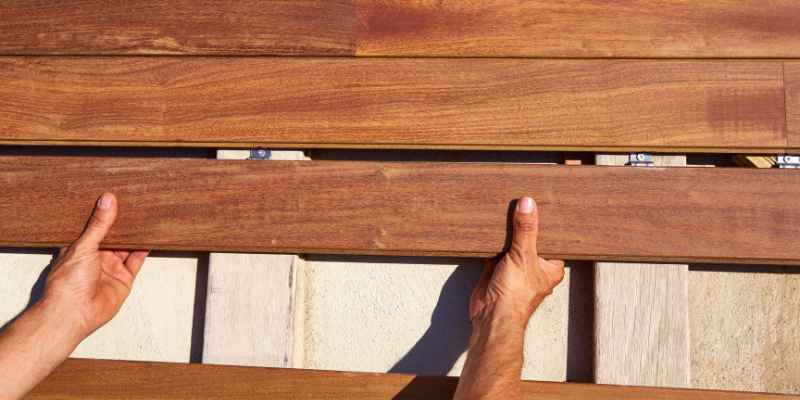To recognize teak wood, look for a long, straight grain pattern with few knots. Higher-grade teak has a uniform, smooth, golden brown surface, while lower-grade teak may have uneven patterns and larger knots.
Teak wood is known for its durability and is often used for both indoor and outdoor furniture due to its resistance to water and pests. The distinct leather-like smell and weight of the wood are additional indicators of genuine teak.
Contrasting teak with oak, teak typically exhibits black striping in its grain, while oak has a finer grain pattern. Checking for the quality of the grain and texture can also help distinguish quality teak wood from cheaper alternatives.
Identifying Teak Wood
Recognizing teak wood involves looking for a long, straight grain pattern, fewer knots, and a uniform and smooth surface. Higher-grade teak will have a gorgeous golden brown color, while lower-grade teak may have uneven patterns and larger knots. You can also identify teak by its leather-like smell and moderately heavy weight.
Grain Pattern
Higher-grade teak showcases a long, straight grain pattern, while lower-grade teak is marked by uneven, interlocking, wavy patterns with larger knots.
Color
Real teak exhibits a beautiful golden brown color, offering a uniform and smooth surface that stands out.
Smell And Weight
True teak wood emits a leather-like scent due to its high natural oil content, showing its authenticity. Additionally, natural teak wood should feel moderately heavy and dense, indicating its quality.
When trying to differentiate between teak and oak, remember that teak often presents a bolder contrast in tones with black striping in its grain, while oak generally features a finer stripey grain.
For outdoor furniture, identifying teak can be done by its distinct smell resembling leather, and its considerable weight due to its hardness and density.
To ensure you have quality teak wood, check for its long, straight grain and coarse texture with varying levels of silica. Quality teaks are typically found in tropical regions with rich soil.
Distinguishing Teak From Other Woods
Teak wood is highly valued for its durability, beauty, and resistance to decay. However, recognizing genuine teak wood can be a challenge, especially when it is often imitated by other woods such as mahogany and oak.
Teak Vs. Mahogany
While both teak and mahogany are known for their rich, warm tones and ability to withstand outdoor environments, there are a few key differences that can help you distinguish between the two:
| Characteristic | Teak | Mahogany |
| Grain Pattern | Long, straight grain pattern | Interlocking grain pattern |
| Color | Golden brown | Reddish or pinkish brown |
| Texture | Smooth surface | Coarser texture |
| Smell | Leather-like smell due to high oil content | No distinct smell |
Teak Vs. Oak
Teak and oak are both hardwoods that are commonly used in furniture construction. Here are a few characteristics that can help you differentiate between the two:
- Color: Teak tends to have a stronger contrast in tones with black striping of the timber grain, while oak has a finer striped grain.
- Grain: Teak wood typically has a long, straight grain pattern, whereas oak has a more varied grain pattern.
- Weight: Teak is generally heavier than oak due to its dense nature.
- Smell: Teak has a distinct leather-like smell, while oak does not have a distinctive scent.
By paying attention to these specific characteristics, you can become more confident in identifying genuine teak wood and distinguishing it from other woods like mahogany and oak.
Recognizing Teak In Furniture
Identifying authentic teak wood furniture involves examining the straight grain pattern and golden brown color of high-grade teak, contrasting with the knots and wavy patterns in lower grades. Real teak emits a leather-like scent due to its natural oil content and feels moderately heavy.
Outdoor Furniture
When recognizing teak in furniture, outdoor furniture stands out due to its natural oil content, which makes it highly resistant to water, bacteria, and pests. Teak also has a distinct smell, similar to leather, due to its high oil content. Moreover, real teak is very hard and heavy, enabling it to withstand outdoor elements, making it a popular choice for outdoor furniture.
Furniture Grain Quality
Another important aspect when recognizing teak in furniture is the grain quality. Higher-grade teak possesses a long, straight grain pattern that gives it a uniform, smooth surface and a gorgeous golden brown color. This superior grain quality is a key characteristic of authentic teak wood furniture. Moreover, the texture of the grain is coarse with varying levels of silica, which is typical of teak wood.
On the contrary, lower-grade teak often exhibits uneven interlocking, wavy patterns, and larger knots, which can help in distinguishing it from higher-grade teak. Additionally, recognizing the grain quality of teak, particularly its long, straight grain or dark lines, can give valuable insights into the authenticity and quality of teak furniture.
Tips For Identifying Real Teak Wood
When identifying real teak wood, look for a long, straight grain pattern with few knots, and a uniform, smooth surface with a golden brown color for higher-grade teak. They also emit a leather-like smell and have a moderate weight. In contrast, lower-grade teak may have irregular patterns and larger knots.
When it comes to identifying real teak wood, there are a few key characteristics you should look out for. By understanding the texture and different types of teak wood, you can easily recognize and differentiate it from other types of wood. Here are some tips to help you identify real teak wood:
Texture
One of the main factors to consider when identifying teak wood is its texture. Real teak wood has a distinct and unique texture that sets it apart from other types of wood. Teak wood typically has a coarse and rough texture due to its high silica content. You can run your hand across the surface of the wood to feel this coarse texture. It’s important to note that the texture of teak wood may vary depending on the grade and age of the wood.
Types Of Teak Wood
Teak wood is available in different types, each with its own unique characteristics. Being familiar with these types can help you recognize real teak wood:
| Type | Description |
|---|---|
| Burmese Teak | This type of teak wood is considered the most valuable and luxurious. It has a rich golden brown color and a straight grain pattern, making it highly sought after in furniture making and boat building. |
| African Teak | African teak, also known as African padauk, has a reddish-brown color and a wavy or interlocking grain pattern. It is commonly used in flooring and decorative veneers. |
| Plantation Teak | Plantation teak is grown in sustainable plantations and is more readily available. It has a lighter color compared to Burmese teak but still possesses the characteristic teak grain pattern. It is commonly used for outdoor furniture and decking. |
By understanding the different types of teak wood, you can easily identify which type you’re dealing with based on its color, grain pattern, and availability.
In conclusion, recognizing real teak wood requires paying close attention to its texture and understanding the different types of teak wood available. By keeping these tips in mind, you’ll be able to distinguish teak wood from other types of wood and make informed decisions when it comes to purchasing or identifying teak wood products.
Expert Advice & Insights
When it comes to recognizing teak wood, it pays to consult the experts. Furniture specialists and woodworking experts have the knowledge and experience to identify the unique characteristics of this prized hardwood. From the grain pattern to the scent and weight, these professionals know exactly what to look for when determining if a piece of wood is genuine teak. So, let’s delve into their expert advice and insights in recognizing teak wood.
From Furniture Specialists
Furniture specialists are well-versed in different types of wood and can easily identify teak wood. Here are some key indicators they use:
- Grain Pattern: Teak wood has a long, straight grain pattern with fewer knots in higher-grade teak.
- Color: Genuine teak wood boasts a beautiful golden brown color with a uniform and smooth surface.
- Texture: The texture of teak wood is generally smooth to the touch, giving it a luxurious feel.
- Weight: Teak wood is moderately heavy but dense, providing a solid and sturdy feel.
- Scent: Teak wood has a distinctive leather-like smell due to its high natural oil content.
From Woodworking Experts
Woodworking experts also have a sharp eye for identifying teak wood. Here’s what they recommend:
- Grain Quality: Teak wood has long, straight grains or dark lines that are unique to this hardwood.
- Texture: The texture of teak wood is coarse due to varying levels of silica, distinguishing it from other woods.
- Contrast: Teak wood exhibits a stronger contrast in tones, often with black striping of the timber grain.
- Weight and Hardness: Teak wood is known for its heavy weight and exceptional hardness, making it resistant to water, bacteria, and pests.
By paying attention to these expert insights, you can confidently recognize teak wood and make informed decisions when it comes to furniture and woodworking projects. Whether you’re an enthusiast or a professional, understanding the unique characteristics of teak wood can enhance your experience with this remarkable hardwood.
Common Misconceptions

Debunking Myths About Teak Wood
Myth 1: Teak wood is always expensive.
Reality: Not all teak wood is pricey; there are different grades available.
Ensuring Authenticity Of Teak Wood
- Myth 2: All hardwoods are as durable as teak.
- Reality: Teak’s natural oils make it exceptionally resistant to weathering and pests.
These myths about teak wood often lead to misconceptions that can impact purchasing decisions. By understanding the truth behind these misunderstandings, you can confidently recognize and appreciate the qualities of teak wood.
Frequently Asked Questions On How To Recognize Teak Wood
How Do You Identify Teak Wood?
To identify teak wood, look for a long, straight grain pattern with few knots. Higher-grade teak has a smooth, uniform surface and a golden brown color, while lower-grade teak may have uneven patterns and larger knots. Real teak also has a leather-like smell and is moderately heavy.
How Do You Test For Teak?
To test for teak, smell for a leather-like scent due to high natural oil content. Also, check if it’s moderately heavy but dense in weight.
How Can You Tell Teak From Oak?
Teak wood has a long, straight grain pattern and fewer knots compared to oak. It has a uniform and smooth surface with a golden brown color. Oak, on the other hand, has a finer stripey grain. Teak also has a leather-like smell and is moderately heavy and dense.
How Do I Know If My Outdoor Furniture Is Teak?
To determine if your outdoor furniture is teak, look for a long, straight grain pattern and fewer knots in higher-grade teak. It should have a smooth, uniform surface and a golden brown color. Lower-grade teak may have uneven, interlocking, or wavy patterns with larger knots.
Additionally, teak has a distinct, leather-like smell due to its natural oil content and is heavy and dense.
Conclusion
Overall, recognizing teak wood comes down to grain pattern, knots, texture, and color. The distinct golden-brown hue and smooth surface of higher-grade teak set it apart. Teak’s unique fragrance and weight also serve as key indicators of authenticity. Always trust your senses when identifying this premium hardwood.

